GRAPHIC INTERVENTION
25 YEARS OF INTERNATIONAL AIDS AWARENESS POSTERS 1985-2010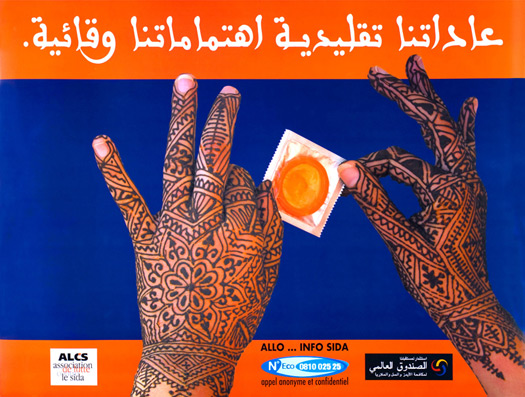
Tradition Doesn't Rhyme with Prevention, Morocco, 2005 Anon, ALCA Association de lutte contre le sida
Graphic Intervention: 25 Years of International AIDS Awareness Posters 1985-2010 draws from an extensive archive of arresting, graphic, intense, and fearless international public health announcements. With 153 examples from 44 countries this exhibition presents a comprehensive overview of the diverse visual strategies employed by government agencies, community activists, grassroots organizations, and motivated citizens to educate the local population. The messages in Graphic Intervention deftly champion pertinent sociopolitical issues - disease research and eradication, world health, international relations, sexual education, social prejudices, and discrimination - in a remarkable way. The exhibition draws upon James Lapides' extensive archive of international AIDS Awareness posters along with posters generously donated to Massachusetts College of Art and Design. You can view the posters in the exhibition and read the catalog essays here.
Graphic Intervention was curated by Elizabeth Resnick, Professor and Chair of Graphic Design at MassArt, and Javier Cortes, Partner and Creative Director at Korn Design, Boston.
Graphic Intervention was curated by Elizabeth Resnick, Professor and Chair of Graphic Design at MassArt, and Javier Cortes, Partner and Creative Director at Korn Design, Boston.
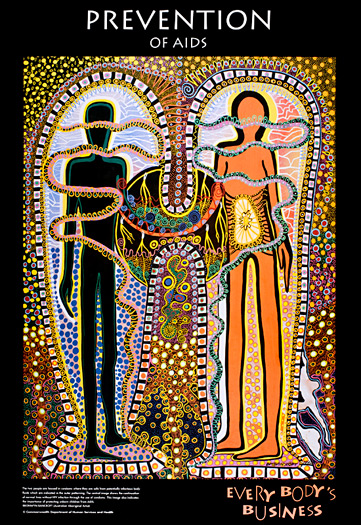
Graphic Intervention
Prevention of AIDS/Everybody's Business — Australia, 1992
Painting: Bronwyn Bancroft
This poster is an excellent example of the use of modern aboriginal motifs in relaying an important message. Here the use of circles within circles is color-coded to convey a series of messages that encompass the male/female figures in an apparent serpentine/snake form — the snake signifies both a benevolent protector of its people and a malevolent punisher of law-breakers. The rainbow serpent's mythology is closely linked to land, water, life, social relationships and fertility.
Graphic Intervention
Mankind is Kind — Austria, ca. 1995
Advertising Agency: Palla Koblinger & Partner, Creative Director: Roman A. Sindelar, Art Director: Bernd Fliesser, Photography: Andreas H. Bitesnich, Gewista, Druckerei Rezegh und Firma Reprodata. PK&P. AIDS-Hilfe Wien
Translation: "Mankind is kind. Humanity is infectious. With HIV-positive people, living with HIV is not."
Two arms crossed at the wrists with the fingers curving toward each other forming the shape of an AIDS ribbon. The message appears at the point where the wrists cross to emphasis the meaning.
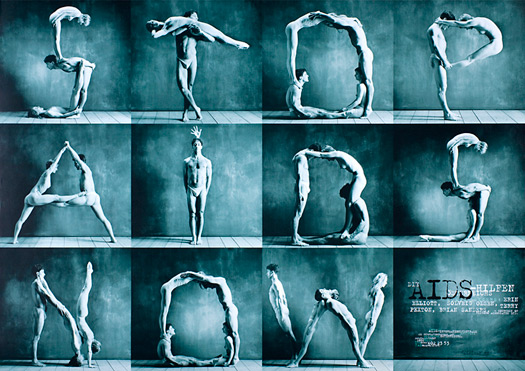
Graphic Intervention
Stop AIDS Now — Austria, ca. 1995
Photo: Claudio Alessandri Design. Momix dancers: Erin Elliott, Solveig Olsen, Terry Pexton, Brian Sanders, courtesy of Riezouw Associates, LTD
Figurative letter forms created from choreographed human bodies spelling out the message.
Graphic Intervention
Grave Monument. AIDS is Still Circulating 1981- — Canada, 2004
Advertising Agency: MARKETEL, Creative Team: Gilles Dusablon, Linda Dawe, Stephane Gaulin
Two men engaged in a sexual encounter in the form of a funerary statue. The visual epitaph that the sculpture conveys — the consequence of practicing unsafe sex, immediately shatters the artistic beauty of the image.
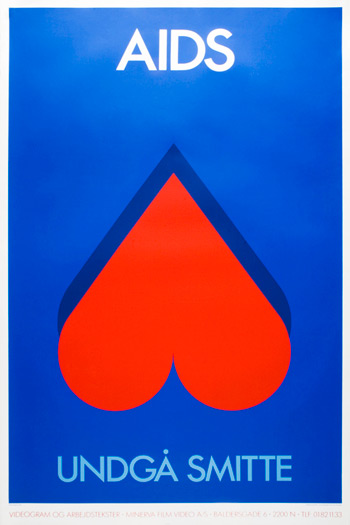
Graphic Intervention
AIDS Avoid Infection — Denmark, 1988
Design: Per Arnoldi, Graphic Production: Lone Michelsen/Tryk: Kai Svendsen
The designer states: "You can't go wrong if you follow your heart! It signifies love, and the interpretation can presumably also be extended to everything that goes with love and the consummation of love, and thus to sex — so it was very relevant as a symbol in the uncertain world from which the first reports of AIDS came. My thinking was this: if a traffic sign meant one thing and the same sign upside down meant the opposite, or at least that you had to take care, then the heart, viewed as a traffic sign, could mean, 'Take care, love or sex ahead!' The heart upside down could by the same logic mean, 'Take care, unsafe sex ahead!' The poster was for an informative/cautionary school film about AIDS in 1988."
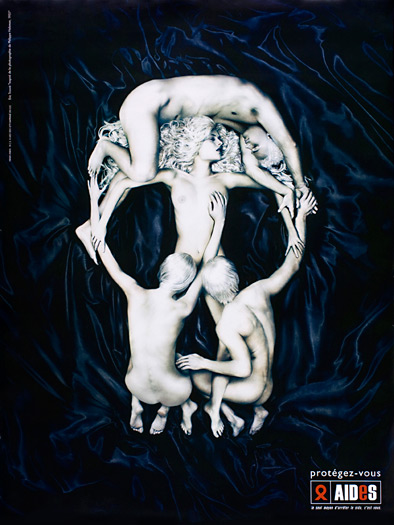
Graphic Intervention
Protect Yourself. The Only Way to Stop AIDS Is You — France, 2003
Agency: TBWA/Paris. Creative Director: Erik Vervroegen, Art Director: Marianne Fonferrier / Stephanie Thomasson, Photography: Eric Traoré, inspired by a photograph made by Philippe Halsman in 1951
The poster image plays with a series of paradoxes to capture the viewer's curiosity and interest. Here the classic sign of danger, the skull, depicts the perils of the AIDS and HIV virus. The paradox is in the series of nudes positioned to form the image of the skull. The aesthetics of the nude figures draws the attention of the viewer while the skull symbolizes the consequences of unprotected sex.
Graphic Intervention
Safety — India, 1995
Design: S. Gosh, printing sponsored by East-West Committee, London for NGO-AIDS cell, Centre for Community Medicine, AIIMS, New Delphi, UNESCO/AIDSTHI workshop, Bihar, India
A married couple — the wife is offering a condom to her husband's outstretched hand. By accepting this from her, it is implied that he has agreed to use it. The message suggests that in order to be safe you must use a condom. The poster image is rendered in an illustrative pictorial style, simple, unembellished and easily accessible to its target audience of men primarily living in the rural areas of India.
Graphic Intervention
Colored Condoms, United Colors of Benetton — Italy, 1991
Concept and Photography: Oliviero Toscani
The poster depicts a photograph of unfurled colorful condoms. Benetton's efforts to raise awareness for safer sex were well received by Health organizations and AIDS groups.
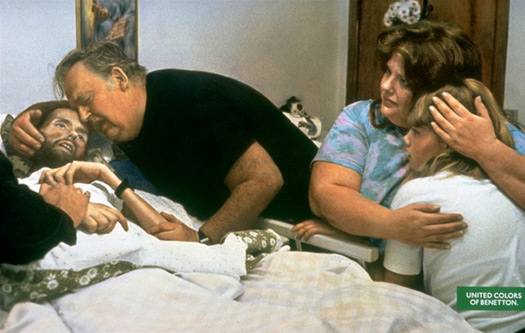
Graphic Intervention
The Death of David Kirby — Italy, 1992
Concept: Tibor Kalman, Oliviero Toscani, Photo: Therese Frare
The photo of AIDS activist David Kirby was taken in his room at the Ohio State University Hospital in May 1990, with his father, sister, and niece at his bedside. The photo, taken in both black and white and color by Therese Frare, was part of a photographic documentary on the lives of clients and caregivers in a hospice for people with AIDS. The photograph was included in LIFE magazine in November 1990 and went on to win the 1991 World Press Photo Award. Tibor Kalman, working with Oliviero Toscani, was preparing a consciousness-raising campaign associated with Benetton products and culture. He saw the Frare photograph in LIFE magazine and suggested that Benetton include it in their advertising campaign. Benetton approached the photographer and Kirby family, gaining consent for the use of the photograph and contributing to an AIDS foundation. When considering whether to stay with black and white or use color the creative team decided that it needed to look like an advertisement, raising the shock value.
Graphic Intervention
INRI in AIDS, Unite Against AIDS in Children — Mexico, 2007
Design: Carlos M. González Manjarrez, UNICEF
In Mexico, the highest percentage of children with AIDS are from indigenous populations. Their mothers contract the virus through their partners, who return infected from abroad. The poster shows a traditional Mexican doll, representing these indigenous children. The poster resonates the visual relationship between the initials INRI inscribed in the Crucifix and the initials AIDS (SIDA), suggesting the doll died from AIDS.
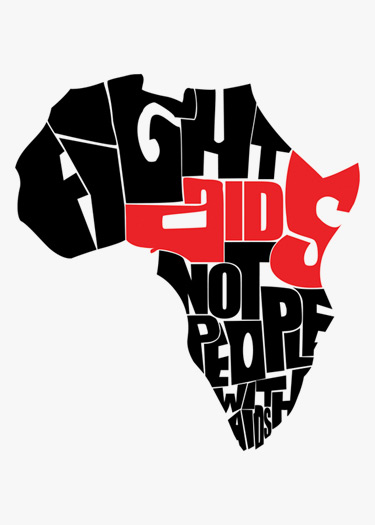
Graphic Intervention
Fight AIDS Not People With AIDS — Portugal, 2009
Design: Sara Gama
This poster was originally created for the 2009 edition of the "Good 50 x 70" poster competition responding to the theme: "Being HIV-positive is not a criminal offense. Governments must focus on education and prevention of the disease rather than repression." The designer employs her typographic message in the shape of the African continent where there is much criminalization of the illness.
Graphic Intervention
Love Life Stop AIDS — Switzerland, 2006
Agency: EURO RSCG Zürich
Translation: "No action without protection. 1. No intercourse without a condom. 2. No sperm or blood in the mouth. The Swiss Federal Office of Public Health and the Swiss Aids Federation: Safer sex is the best way to protect yourself from HIV and other sexually transmitted diseases."
This poster from a series of two, depicts three men playing ice hockey suggesting their activity is dangerous as they are unclothed and unprotected.
Graphic Intervention
What Does a Person With AIDS Look Like? — Uganda, ca 1993
Anon, Uganda School Health Kit on AIDS Control (Item 6) Ministry of Education, Ministry of Health (AIDS Control Programme), UNICEF Kampala
Images of everyday people, surrounded by an explanatory text that questions the viewer's preconceived notion of AIDS and the rumors and misconceptions that surround it. There is a complete absence of any symbolic or decorative element within the poster, even the use of color is kept to a minimum, so as to not distract the viewer from the central message being conveyed by the poster. The poster operates on two levels — first to dispel false notions about people with the disease and the AIDS epidemic itself. Second, to educate the mass population by identifying more acceptable yet equally chronic diseases such as typhoid, cancer, TB, measles and even alcoholism. The message suggests that one should not assume that someone has AIDS just because they appear sick, along with the importance of testing for people who suspect they have AIDS.
Graphic Intervention
The Other Night Charlie Brought Home a Quart of Milk, a Loaf of Bread and a Case of AIDS — USA, 1994
Agency: Saatchi & Saatchi
In the U.S. many early AIDS prevention messages were aimed predominantly at the white gay male community and intravenous drug users. With a disease involving sexuality, the biggest challenge has been identifying what can actually be shown on a poster. Sexual behavior is deeply rooted in culture and tradition, and messages to raise awareness and encourage preventive behavior need to take into consideration the living habits of the intended audience.
Graphic Intervention
National School Day for the Prevention of AIDS, May 23 — Venezuela, ca. 1995
Anon, OPL-SIDA
In this poster, "Children against AIDS" is a strong rally cry for solidarity. The message promotes hope, happiness, and health through its colorful illustration imagery and upbeat handling of the subject matter
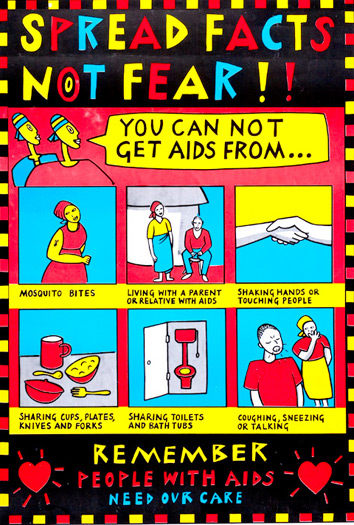
Graphic Intervention
Spread Facts Not Fear — Zimbabwe, ca. 1993
Design: AIDS Counseling Trust (ACT)
This poster uses bright primary colors, playful hand-drawn type and simple illustrations reminiscent of comic books to draw the viewer in, and make accessible what may otherwise be a frightening or off-putting message.

